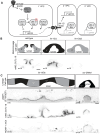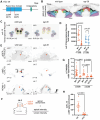This is a preprint.
The Pax transcription factor EGL-38 links EGFR signaling to assembly of a cell-type specific apical extracellular matrix in the Caenorhabditis elegans vulva
- PMID: 39282387
- PMCID: PMC11398461
- DOI: 10.1101/2024.09.04.611291
The Pax transcription factor EGL-38 links EGFR signaling to assembly of a cell-type specific apical extracellular matrix in the Caenorhabditis elegans vulva
Update in
-
The Pax transcription factor EGL-38 links EGFR signaling to assembly of a cell type-specific apical extracellular matrix in the Caenorhabditis elegans vulva.Dev Biol. 2025 Jan;517:265-277. doi: 10.1016/j.ydbio.2024.10.008. Epub 2024 Nov 1. Dev Biol. 2025. PMID: 39489317
Abstract
The surface of epithelial tissues is covered by an apical extracellular matrix (aECM). The aECMs of different tissues have distinct compositions to serve distinct functions, yet how a particular cell type assembles the proper aECM is not well understood. We used the cell-type specific matrix of the C. elegans vulva to investigate the connection between cell identity and matrix assembly. The vulva is an epithelial tube composed of seven cell types descending from EGFR/Ras-dependent (1°) and Notch-dependent (2°) lineages. Vulva aECM contains multiple Zona Pellucida domain (ZP) proteins, which are a common component of aECMs across life. ZP proteins LET-653 and CUTL-18 assemble on 1° cell surfaces, while NOAH-1 assembles on a subset of 2° surfaces. All three ZP genes are broadly transcribed, indicating that cell-type specific ZP assembly must be determined by features of the destination cell surface. The paired box (Pax) transcription factor EGL-38 promotes assembly of 1° matrix and prevents inappropriate assembly of 2° matrix, suggesting that EGL-38 promotes expression of one or more ZP matrix organizers. Our results connect the known signaling pathways and various downstream effectors to EGL-38/Pax expression and the ZP matrix component of vulva cell fate execution. We propose that dedicated transcriptional networks may contribute to cell-appropriate assembly of aECM in many epithelial organs.
Figures






Similar articles
-
The Pax transcription factor EGL-38 links EGFR signaling to assembly of a cell type-specific apical extracellular matrix in the Caenorhabditis elegans vulva.Dev Biol. 2025 Jan;517:265-277. doi: 10.1016/j.ydbio.2024.10.008. Epub 2024 Nov 1. Dev Biol. 2025. PMID: 39489317
-
A multi-layered and dynamic apical extracellular matrix shapes the vulva lumen in Caenorhabditis elegans.Elife. 2020 Sep 25;9:e57874. doi: 10.7554/eLife.57874. Elife. 2020. PMID: 32975517 Free PMC article.
-
Epithelial Shaping by Diverse Apical Extracellular Matrices Requires the Nidogen Domain Protein DEX-1 in Caenorhabditis elegans.Genetics. 2019 Jan;211(1):185-200. doi: 10.1534/genetics.118.301752. Epub 2018 Nov 8. Genetics. 2019. PMID: 30409789 Free PMC article.
-
The Caenorhabditis elegans cuticle and precuticle: a model for studying dynamic apical extracellular matrices in vivo.Genetics. 2024 Aug 7;227(4):iyae072. doi: 10.1093/genetics/iyae072. Genetics. 2024. PMID: 38995735 Free PMC article. Review.
-
C. elegans Apical Extracellular Matrices Shape Epithelia.J Dev Biol. 2020 Oct 6;8(4):23. doi: 10.3390/jdb8040023. J Dev Biol. 2020. PMID: 33036165 Free PMC article. Review.
References
Publication types
Grants and funding
LinkOut - more resources
Full Text Sources
Research Materials
Miscellaneous
